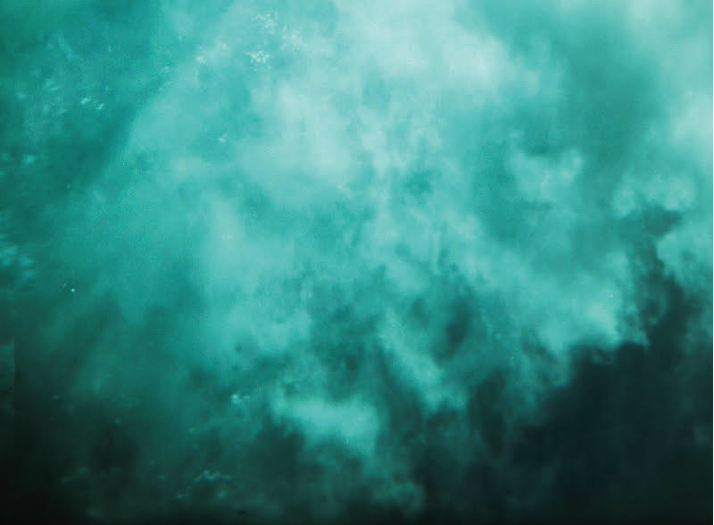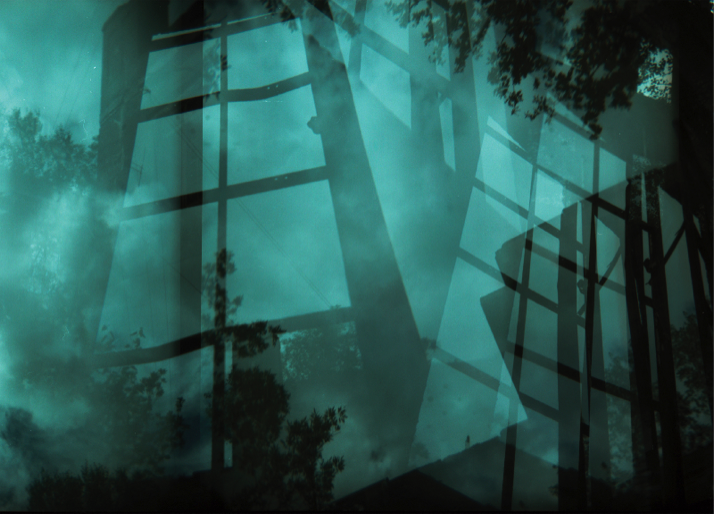Quintan Ana Wikswo’s The Hope of Floating Has Carried Us This Far pours details that coalesce and hover, milky and diffused, yet concrete and visceral, into the vast container called “psyche.” An oceanic motif provides a fitting way to reflect upon the nature of experience, its watery memories, and fluid interpretation of linear time. It’s here that place and psyche, geography and emotion, and time and desire have been blurred and muddled, in the same way that they do as they lay in wait to be plucked from the abyss of memory and brought into present time, together again; clear, coherent, resolved.
The nebulous nature of place in which emotions are inextricably allied to location, and in which emotions are fastened to memories by way of sensory detail forces the question: “What is place?” And then: “Where does it exist?”

With careful consideration, double—and sometimes triple—exposed photographs are apportioned among these pages and further lend to the nebulous quality of place. Natural objects, such as ponds and trees and patches of sky peeking through branches, are overlaid against buildings and structures, or reflections of recognizable objects—but these things are unable to be specifically contextualized within a particular physical or geographical environment. What would ordinarily be conjured in the reader’s imagination, is readily provided in full color to create an additional layer of metaphor and meaning against the text.
Geographic place is hinted at in the titles of these stories, however, they read less like stories with a finite end and beginning and more like lengthy prose poems that flow—or float—seamlessly from one into the next. What initially appears as a group of stories eventually unfolds as a narrative with an overall arc commonly known as the hero’s journey; in this case, a journey through the aftermath of twenty-first century post-war experience.
“The Cartographer’s Khorovod” opens the collection, a piece that muses on navigation, the self-imposed prison of the mind’s making, the exchange of letters between lovers during a time of war, longing, and separation.
It was likewise intimated by a small and well-placed few that hers was a front
for the resistance, a secret meeting place for strategist and tacticians who
schemed with sympathetic armies to the west and east.
She, they said, was the cartographer, making maps of what was and what
had been, what is and what could be. (20)
Cartography, now, is not merely mapmaking, but rather an historical account of experience, a trajectory that begins a descent into despair, with fearless abandon of pretense and a stunning degree of honesty.
She is not here because I chose otherwise. Existence is the consequence of
consequence, a nested series of events that unfurl themselves with all the
inexorable exuberance of spring. This is what you planted: this is what now
springs from your soil. And each year I must look on. Aghast, as the lonesome
bright green sprout leaps forward from the blackened soil to remind me of
the seed I cast there long ago. (3)
What comes before and after war is hinted at by the reference to the circular dance of the Khorovod, mentioned in the title, although no scene of the literal dance appears. The devastation of war and the imprint it leaves behind becomes an analogy to the larger scope of unnavigable existential questions, questions that cannot be mapped, questions which swirl ‘round and ‘round like an unending dance.
“The Anguillidae Eater,” the third story in the collection, continues the hero’s journey further into the depths of creation and destruction. Experience and its reflexive nature is now imposed on a corporeal body that is learning what it means to exist.
The ships are anchored far out to sea.
The small boats are empty at the shore.
At dawn they will again be filled with eggs.
He returns.
My skin is smooth and pale as duck fat.
He returns—I am more fierce than wolves.
I have clawed open seashells with my fingers then crushed and eaten them.
I have honed my teeth to points with handfuls of sand.
He harvests the egg with his tongue.
He leaves with my egg in his bag. (102)
Anguillidae, the elusive freshwater eels whose reproductive functions science has yet to identify, are freshwater carnivores. A cycle of life and death occurs in this piece. A man who comes from ships appears in order to take eggs that emerge from between the narrator’s legs. The narrator creates sustenance from the eels, which are eaten and taken in to the body as fuel to create more eggs, later harvested again.
The precursor to any journey is the desire to evolve, to change, to create something new, and in doing so, the old must be left behind. The Anguillidae Eater, like other heroes such as Perseus or Jason, must sacrifice something in exchange for something else.
Deeper into the novel’s journey, “My Nebulae, My Antilles” seeks to understand the identity that is emerging as a consequence of change, devastation, and displacement.
Her tactics remain vague.
This discussion incongruous, superfluous.
What of our more esoteric conversation?
Why now this intrusion?
I wrote back to the Antilles and told her to cease clarifying her schemes for
artistry and insurrection:
Why now this inclusion? What of our sartorial distractions? Please—tell me
nothing of what you did today, of what foods you ate, or of your fragile
frustrations.
Let us go diving in a different sea.
Let us stay down so long we come up with barnacles, with gills. (142)

Somewhere—a different sea in the Caribbean Antilles—may as well be nowhere, and is no different than a far-off distant place in the galaxy—a nebula. Identity is no longer defined by geography or circumstance, and thus the hero has arrived.
The collection concludes with “The Double Nautilus,” a piece in this collection reminiscent of a manifesto, that summarizes and also rebels against the work’s trajectory. Readers have traveled the journey to the darkness of despair and are returning to the light. The nautilus, a geometrically and mathematically constructed shape, spirals in on itself as all journeys eventually do, and as all aspects of the psyche eventually rejoin through transformation at a single, central point. The reader then, has floated alongside the narrator and returned.
The sheen of this place seems a kind of membrane, as though a thin layer of
mineral oils lubricates its surface, and now I feel this chamber is instead a
corridor, a canal, a means of passage, for what I cannot say. (276)
The descent into darkness is never a known process prior to the heroic experience. And even after the hero has reemerged, the integration of the layers of meaning the journey has revealed can be elusive.
We have reached the point at the base of the whorl. The two nautilus meet at
the aperture of us. We are below the sea, below everything. We are
subterranean tunnel lovers, and the single shell now contains us both, with
no membrane in between. The divergent boundary, reversed. Self-congruent.
She says this has been here all this time. That we merely needed the strength
to go deep enough. (283)
These stories provide a steady drift through the place that all readers, at least for a short time, have visited: the place of despair. Where the reader meets the text is the place where that experience floats, steady, even, without too much upset, without too much rocking to and fro—a steady movement from one story to the next carrying, carrying, carried to the end.
Akin to the steady tension present in McCarthy’s No Country for Old Men, we wait, we wait, and read and read some more, hoping for that elusive resolution that will dispel despair and reinvigorate an existence no longer subjugated by “place.” Readers can reflect that place is located, perhaps, only in the imagination.

The Hope of Floating Has Carried Us This Far is a reminder that plumbing the depths of experience may not always yield a positive result. Do all heroes return home with the transformed self? Is the journey propelled by the prospect of a new resolution? Do the answers to these questions matter so long as the journey has begun? For even in the darkest depths of the quest, the psyche, the determination, is the tiny crack of light that can penetrate these places. And that crack of light is hope.
